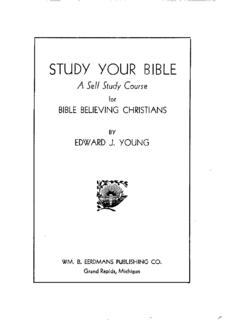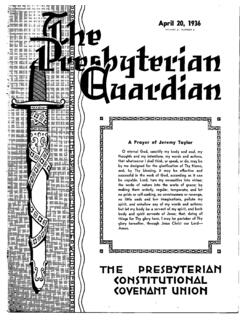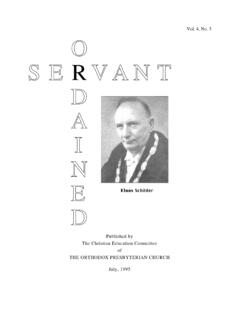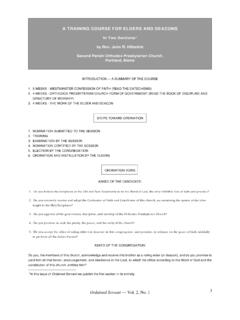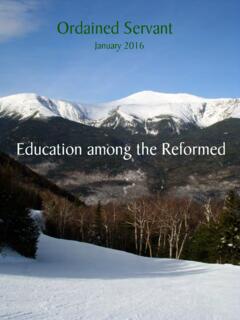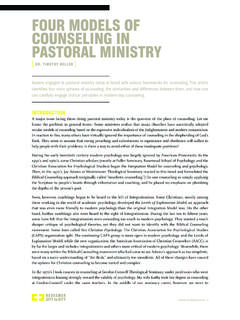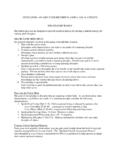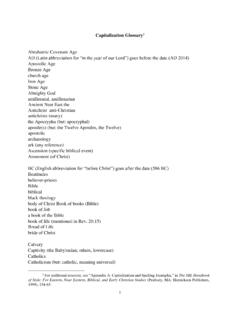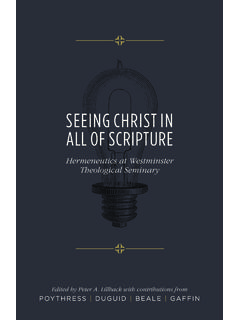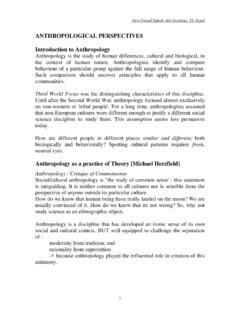Transcription of ZKDW LV PDQ
1 November 2017 Ordained Servantwhat is man?Ordained Servant Online A Journal for Church Officers E- ISSN 1931-7115 CURRENT ISSUE: WHAT IS MAN? November 2017 From the Editor The doctrine of man is central to the modern debate about sexual identity. The rejection of transcendent reality by the modern mind sets people free to seek to redefine the human. In my editorial essay, Diminishing Humanity: How the Modern World Is Dehumanizing Us, I explore the theme of dehumanization in modernity. Carl Trueman reviews the work of a relatively unknown twentieth-century Italian political and cultural philosopher in his review of Augusto Del Noce, The Crisis of Modernity. His exploration of the disenchantment of modern life in terms of an assumed materialism is profound. The human quest for rest without God leads to the exhaustion of hope. God has designed it that way, so that we may not find rest outside of resting in him. The Sabbath trajectory of human life is meant to drive us to our Creator, in whom true rest may only be found.
2 I explore this theme in George Herbert s poem The Pulley. John Muether continues the celebration of Reformation 500 as he explores the confessional development of the Reformation with Reformed Confessions: Canons of the Synod of Dort (1619). This demonstrates the doctrinal consistency of biblically based ecclesiastical symbols forged in the ecumenical spirit of a truly ecumenical endeavor. In another area of historical exploration, Danny Olinger gives us chapter 10 of his Vos biography, Geerhardus Vos: Grace and Glory, in which he explores the sermonic production of Vos. Few in number, Vos s sermons provide a rich example of biblical theology applied appropriately and powerfully to the Princeton seminary students of Vos s day. David Noe s review article on Kirk Summers, Morality after Calvin focuses on another volume of historical theology studies that demonstrates the genetic connection with the theology of the magisterial reformers. Theodore Beza (1519 1605) is considered to be among the first generation after the magisterial reformers.
3 Beza s high commitment to exegesis as the basis of his theology undermines the false thesis that Post-Reformation dogmatics is a synthetic system built on human logic rather than divine revelation. William Kessler reviews Joel Beeke s and Randall Pederson s Meet the Puritans. This great resource for one of the central streams of our tradition is encyclopedic in its scope. Finally, enjoy the simple profundity of John Bunyan s The Shepherd Boy s Song in the Valley of Humiliation. Blessings in the Lamb, Gregory Edward Reynolds CONTENTS ServantThoughts Gregory Reynolds, Diminishing Humanity: How the Modern World Is Dehumanizing Us Gregory Reynolds, The Pulley: A Theological Reflection ServantHistory John Muether, Reformed Confessions: Canons of the Synod of Dort (1619) Danny Olinger, Geerhardus Vos: Grace and Glory ServantReading Carl Trueman, review, Augusto Del Noce, The Crisis of Modernity David Noe, review article, Kirk Summers, Morality after Calvin: Theodore Beza s Christian Censor and Reformed Ethics William Kessler, review of Beeke and Pederson, Meet the Puritans ServantPoetry John Bunyan, The Shepherd Boy s Song in the Valley of Humiliation FROM THE ARCHIVES ANTHROPOLOGY Defining the Human: Personal Identity in Theological Perspective.
4 (A. Craig Troxel) 17 (2008): 138 41. _____ Ordained Servant exists to help encourage, inform, and equip church officers for faithful, effective, and God-glorifying ministry in the visible church of the Lord Jesus Christ. Its primary audience is ministers, elders, and deacons of the Orthodox Presbyterian Church, as well as interested officers from other Presbyterian and Reformed churches. Through high-quality editorials, articles, and book reviews, we will endeavor to stimulate clear thinking and the consistent practice of historic, confessional Presbyterianism. ServantThoughts Diminishing Humanity: How the Modern World Is Dehumanizing Us1 _____ by Gregory E. Reynolds The psalmist s age-old question, What is man that you are mindful of him? is now the great question of our age, as technology has given us tremendous power to manipulate the created order. For all its benefits, it has also given sinful, autonomous man the false idea that he can redesign human nature.
5 This is a dangerous concept, the hazards of which are becoming more evident with each passing year. Without the Creator s view of what the being he has created is, dehumanization, which began with original sin, is inevitable. Notice that the psalmist s question is addressed to God. It is precisely the lack of transcendent reality in the modern mind that leads to the illusion of pervasive human control. The apotheosis of the human ends ironically with dehumanization. The problem of dehumanization has emerged as one of the fundamental problems of the modern world, especially since the beginning of the Industrial Revolution. The Christian view of humanity, based on the transcendent special revelation of God s Word, offers unique intellectual and spiritual tools to analyze, critique, and present solutions to the problem. Tragically both the church and the world seem only to be able to feel the pain of our diminishing humanity without really understanding the problem, much less its solution.
6 There is a hint of dehumanization in the International Style of architecture. This style grew out of Walter Gropius s Bauhaus School, uniting art and technology. For example, Le Corbusier s mass housing machines for living were built to human proportions, but notably lacked the humanly important elements of decoration and The apotheosis of science and technology is diminishing our humanity in significant ways so that we are becoming T. S. Eliot s hollow men. 3 C. S. Lewis warned that modern education was producing men without chests. 4 As quantity replaces quality, virtue is shoved aside by technique. At the level of popular culture, the symptoms are legion. We hear people say, I feel like a number. I get lost in the crowd. Nobody cares. Whatever! Our virtual connections have made us alone together, longing for community, while traditional social connections are fast We are amazed to get a live person on the other end of the phone line when 1 Originally Reduction, Retreat, Reformation: A Christian Response to Contemporary Dehumanization, a lecture given on January 23, 1989, to the class of Dr.
7 Dennis Roark, Christianity and the Natural Sciences, The King s College, Briarcliff Manor, NY. This version is revised and expanded. 2 First century BC Roman architect Vitruvius s three rules of good architectural design were expounded in his foundational The Ten Books of Architecture: firmness (firmitas structural integrity), commodity (utilitas usefulness), and delight (venustas beauty). 3 T. S. Eliot s poem The Hollow Men was published in 1925. 4 Lewis, The Abolition of Man (New York: Macmillan, 1947), 1. 5 Sherry Turkle, Alone Together: Why We Expect More from Technology and Less from Each Other (New York: Basic Books, 2011). we call a business or other institution. The media have so saturated us with exposure to disasters throughout the world that we become callous to suffering. Entire population groups have been liquidated: White Russians in Russia, Armenians, Jews in Germany, Mosquito Indians in Nicaragua, Curds in Iraq, Sudanese, and the unborn daily in the Western World.
8 There is also a reflection of diminishing humanity in art and literature, mirrors of our culture. In Marcel Duchamp s Nude Descending a Staircase, man disappears almost entirely. Swedish filmmaker Ingmar Bergman said of his film The Silence in 1963, God is dead. There is only silence in the universe. 6 Much of modern art is, as George Roche said, the nightmares of a materialistic society. 7 The rejection of the God of the Bible diminishes the humanity in its self-expression. I. THE DIMINISHING OF OUR HUMANITY Our rejection of a Christian view of humanity was the real problem as the rejection of any transcendent reality became an assumption of the modern mind. As G. K. Chesterton is believed to have said: When people reject Christianity, it is not that they believe in nothing, but they will believe in anything. 8 The late Jacque Barzun maintained that dehumanization is brought about by the sway of number and quantity. 9 Science is an all pervasive energy, for it is at once a mode of thought, a source of strong emotion, and a faith as fanatical as any in history.
9 10 According to Daniel & Revelation the progress of world history in its idolatry tends toward diminishing our humanity. Thus the symbolic image of beasts. Paul describes the dehumanizing effects of idolatry as it degenerates to sexual perversion: Claiming to be wise, they became fools, and exchanged the glory of the immortal God for images resembling mortal man and birds and animals and creeping things. Therefore God gave them up in the lusts of their hearts to impurity, to the dishonoring of their bodies among themselves, because they exchanged the truth about God for a lie and worshiped and served the creature rather than the Creator, who is blessed forever! Amen. (Rom 1:22 25) A. A Brief Survey of Diminishing Our Humanity Contrary to many thinkers like Alfred North Whitehead and Francis Schaeffer, dehumanization did not begin with the twentieth century or the line of despair formed by the philosophers Immanuel Kant, G. W. F. Hegel, and the Enlightenment.
10 Humanity began to be diminished at the point of the historic Fall of Adam. When Adam chose to worship created reality and seek meaning apart from God, his humanity became diminished. Romans 1:25 they exchanged the truth about God for a lie and worshiped and served the creature rather than the Creator, who is blessed forever! Amen. This is what the Bible calls idolatry: locating ultimate loyalty and devotion in the created order rather than in the personal Trinity. 6 Francis A. Schaeffer, How Should We Then Live? The Rise and Decline of Western Thought and Culture (Grand Rapids: Revell, 1976), 202. 7 George Roche, A World without Heroes: The Modern Tragedy (Hillsdale, MI: Hillsdale College Press, 1987), 71. 8 mile Cammaerts, The Laughing Prophet: The Seven Virtues and G. K. Chesterton (London: Methuen, 1937), 211. The quote is actually Cammearts s interpretation of something Father Brown says in The Oracle of the Dog (1923).
